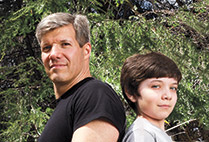Archaeologist Stephanie Simms was digging at the Escalera al Cielo site in a hilly region of rural Yucatán, Mexico, when she discovered a trove of clay balls the size of plums. There were hundreds of them, buried at the edge of what functioned as a Maya kitchen 1,000 years ago.
Ball-shaped artifacts are not uncommon, and Simms (GRS’13) likes to joke that male researchers tend to theorize that they are ammunition, while women envision domestic uses. In this case, the location and appearance of the balls—they were found with burn marks in what was presumably a cooking area—indicate that they were used for distributing and prolonging heat in pit ovens.
Months later, at the College of Arts & Sciences Laboratory of MicroStratigraphy, an analysis of the balls’ mineral composition strongly supported Simms’ theory. The ancient narrative etched into their material properties suggests that the balls, crafted from the local, clay-rich earth, were dried in the hot sun and then cooked, like reusable coals, again and again and again, at heat as high as 1,300 degrees Fahrenheit.
“It was this wow moment,” says Simms, whose research and dissertation focus is on pre-Hispanic Maya food production, collection, preparation, and consumption.

Clay balls the size of plums, uncovered in Yucatán, Mexico, by archaeologist Stephanie Simms, held traces of starch from maize, beans, and squash, a strong indicator that they had been in contact with food. Photo by Cydney Scott
Like stones, clay is an efficient retainer of heat, and today the Maya still line pits with stones, build a fire on top, and cook root vegetables or corn. Even before the balls’ history of exposure to high heat had been confirmed, Simms extracted residues from cracks in the balls and found traces of starch from maize, beans, and squash, a strong indicator that the balls had been in contact with food.
In the lab, Simms used samples of Yucatán clay to re-create the work of the Maya. “I cooked the balls in different places at different temperatures and saw these interesting iron depletion patterns,” says Simms, who ran the experiment in a closed environment—a furnace—as well as in an open outdoor fire pit.
The next step was to enlist the help of Francesco Berna, a CAS adjunct assistant professor of archaeology and an expert in ancient pyrotechnology, as well as of a state-of-the-art analytic tool called Fourier transform infrared spectroscopy (FTIR). When rocks and clay are exposed to extreme temperatures, their mineral composition changes; FTIR, guided by a microscope, can meticulously graph those changes.
With the test balls as reference, Berna calibrated the thermal behavior of soil from the site, which served as a point of comparison when he analyzed the excavated samples. The most common mineral in the Yucatán soil, kaolinite, survives up to 500 degrees Celsius (932 degrees Fahrenheit), while smectite and mica survive up to 700 degrees Celsius (1,292 degrees Fahrenheit). Knowing the concentrations of these minerals in the starting materials, Berna was able to “map” the balls’ histories of heat exposure. He and Simms found that the balls from the site burned at temperatures comparable to the test balls they burned in an open fire pit.
Based on the evidence, which they outline in the 2013 issue of the Journal of Archaeological Science, Berna and Simms are fairly certain the Maya formed the balls with clay left over from crafting pottery. “Kaolin is really good for this purpose,” says Berna. “It’s nonswelling and won’t crack, so it’s perfect for pottery and ceramics.” The researchers also believe that because the grain residue is small and random, the balls probably had little direct contact with food and were used mainly to control the distribution, and extend the life, of the oven’s heat. The balls could also have been used for “hot-rock” boiling, either placed in water or in bean pots, a technique Native Americans still use, but with stones rather than clay.
Simms next will turn her attention to identifying and analyzing the elusive cooking hearths, if any survived. And more analysis is needed to determine whether use of the fired clay balls was restricted to the Puuc region, where they were found, or was a common practice among all the Maya. It seems clear that for at least these hilltop settlements, the clay balls formed an important part of what the researchers call “the culinary toolkit.”

















































Kudos to Dr. Simms!